child restraint FIAT TALENTO 2020 Owner handbook (in English)
[x] Cancel search | Manufacturer: FIAT, Model Year: 2020, Model line: TALENTO, Model: FIAT TALENTO 2020Pages: 236, PDF Size: 4.86 MB
Page 28 of 236
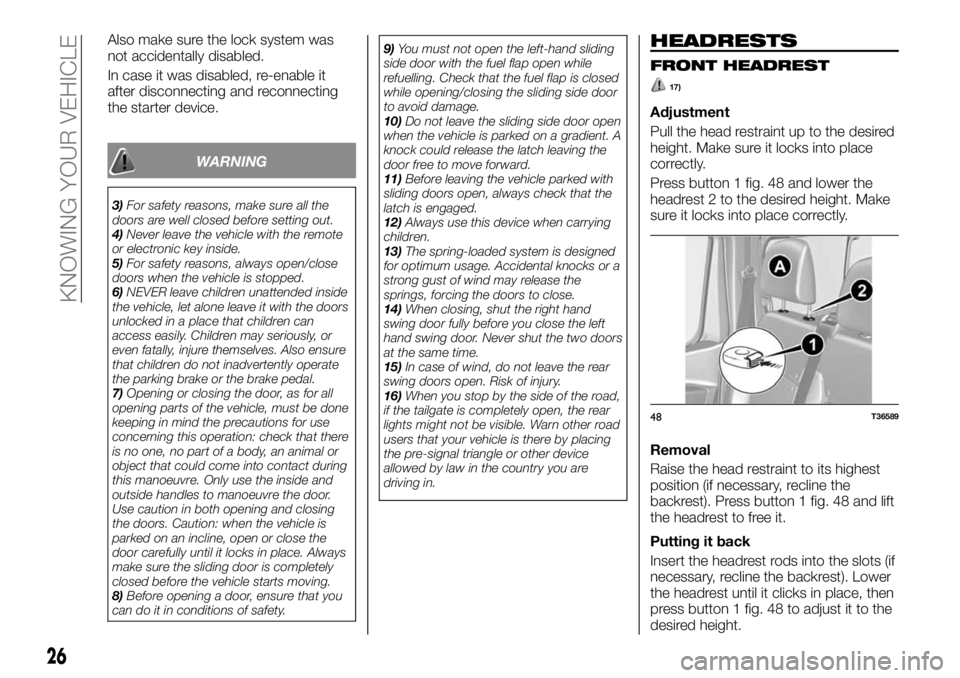
Also make sure the lock system was
not accidentally disabled.
In case it was disabled, re-enable it
after disconnecting and reconnecting
the starter device.
WARNING
3)For safety reasons, make sure all the
doors are well closed before setting out.
4)Never leave the vehicle with the remote
or electronic key inside.
5)For safety reasons, always open/close
doors when the vehicle is stopped.
6)NEVER leave children unattended inside
the vehicle, let alone leave it with the doors
unlocked in a place that children can
access easily. Children may seriously, or
even fatally, injure themselves. Also ensure
that children do not inadvertently operate
the parking brake or the brake pedal.
7)Opening or closing the door, as for all
opening parts of the vehicle, must be done
keeping in mind the precautions for use
concerning this operation: check that there
is no one, no part of a body, an animal or
object that could come into contact during
this manoeuvre. Only use the inside and
outside handles to manoeuvre the door.
Use caution in both opening and closing
the doors. Caution: when the vehicle is
parked on an incline, open or close the
door carefully until it locks in place. Always
make sure the sliding door is completely
closed before the vehicle starts moving.
8)Before opening a door, ensure that you
can do it in conditions of safety.9)You must not open the left-hand sliding
side door with the fuel flap open while
refuelling. Check that the fuel flap is closed
while opening/closing the sliding side door
to avoid damage.
10)Do not leave the sliding side door open
when the vehicle is parked on a gradient. A
knock could release the latch leaving the
door free to move forward.
11)Before leaving the vehicle parked with
sliding doors open, always check that the
latch is engaged.
12)Always use this device when carrying
children.
13)The spring-loaded system is designed
for optimum usage. Accidental knocks or a
strong gust of wind may release the
springs, forcing the doors to close.
14)When closing, shut the right hand
swing door fully before you close the left
hand swing door. Never shut the two doors
at the same time.
15)In case of wind, do not leave the rear
swing doors open. Risk of injury.
16)When you stop by the side of the road,
if the tailgate is completely open, the rear
lights might not be visible. Warn other road
users that your vehicle is there by placing
the pre-signal triangle or other device
allowed by law in the country you are
driving in.
HEADRESTS
FRONT HEADREST
17)
Adjustment
Pull the head restraint up to the desired
height. Make sure it locks into place
correctly.
Press button 1 fig. 48 and lower the
headrest 2 to the desired height. Make
sure it locks into place correctly.
Removal
Raise the head restraint to its highest
position (if necessary, recline the
backrest). Press button 1 fig. 48 and lift
the headrest to free it.
Putting it back
Insert the headrest rods into the slots (if
necessary, recline the backrest). Lower
the headrest until it clicks in place, then
press button 1 fig. 48 to adjust it to the
desired height.
48T36589
26
KNOWING YOUR VEHICLE
Page 32 of 236
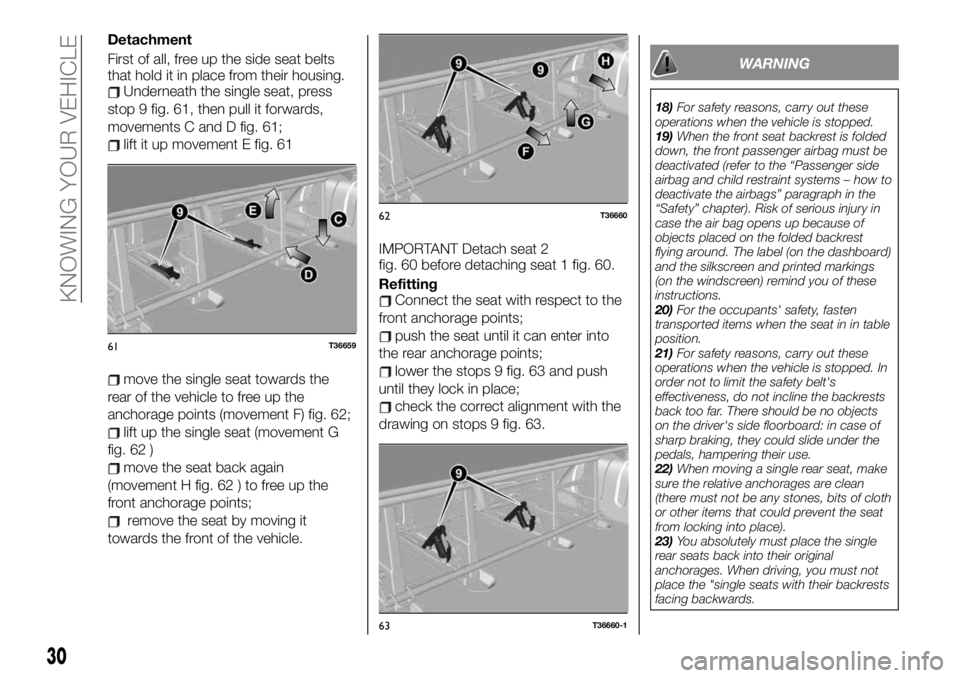
Detachment
First of all, free up the side seat belts
that hold it in place from their housing.
Underneath the single seat, press
stop 9 fig. 61, then pull it forwards,
movements C and D fig. 61;
lift it up movement E fig. 61
move the single seat towards the
rear of the vehicle to free up the
anchorage points (movement F) fig. 62;
lift up the single seat (movement G
fig. 62 )
move the seat back again
(movement H fig. 62 ) to free up the
front anchorage points;
remove the seat by moving it
towards the front of the vehicle.IMPORTANT Detach seat 2
fig. 60 before detaching seat 1 fig. 60.
Refitting
Connect the seat with respect to the
front anchorage points;
push the seat until it can enter into
the rear anchorage points;
lower the stops 9 fig. 63 and push
until they lock in place;
check the correct alignment with the
drawing on stops 9 fig. 63.
WARNING
18)For safety reasons, carry out these
operations when the vehicle is stopped.
19)When the front seat backrest is folded
down, the front passenger airbag must be
deactivated (refer to the “Passenger side
airbag and child restraint systems – how to
deactivate the airbags” paragraph in the
“Safety” chapter). Risk of serious injury in
case the air bag opens up because of
objects placed on the folded backrest
flying around. The label (on the dashboard)
and the silkscreen and printed markings
(on the windscreen) remind you of these
instructions.
20)For the occupants' safety, fasten
transported items when the seat in in table
position.
21)For safety reasons, carry out these
operations when the vehicle is stopped. In
order not to limit the safety belt's
effectiveness, do not incline the backrests
back too far. There should be no objects
on the driver's side floorboard: in case of
sharp braking, they could slide under the
pedals, hampering their use.
22)When moving a single rear seat, make
sure the relative anchorages are clean
(there must not be any stones, bits of cloth
or other items that could prevent the seat
from locking into place).
23)You absolutely must place the single
rear seats back into their original
anchorages. When driving, you must not
place the "single seats with their backrests
facing backwards.
61T36659
62T36660
63T36660-1
30
KNOWING YOUR VEHICLE
Page 98 of 236
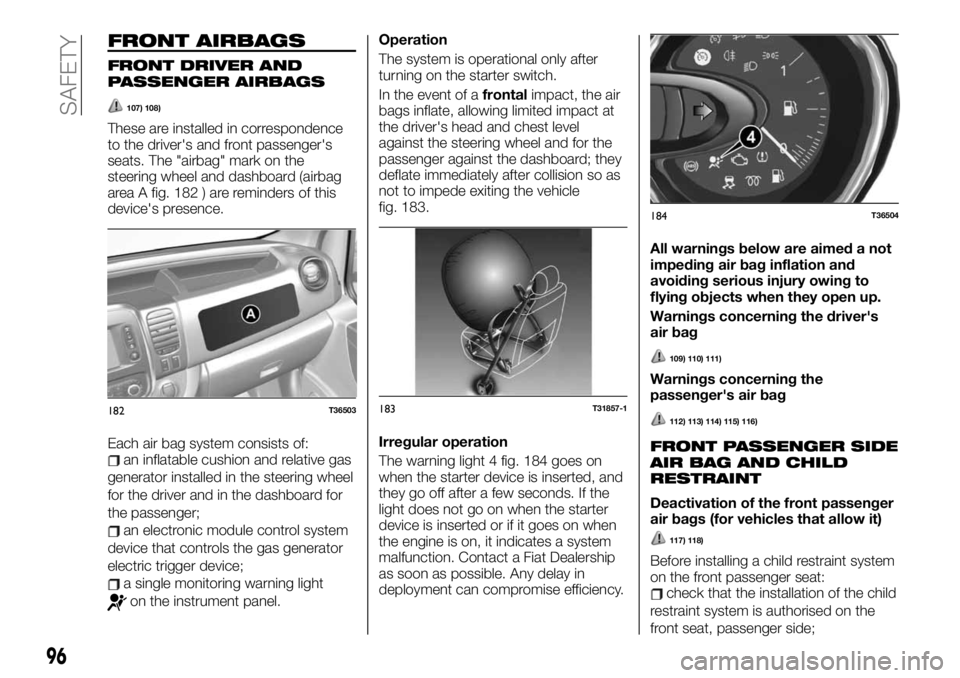
FRONT AIRBAGS
FRONT DRIVER AND
PASSENGER AIRBAGS
107) 108)
These are installed in correspondence
to the driver's and front passenger's
seats. The "airbag" mark on the
steering wheel and dashboard (airbag
area A fig. 182 ) are reminders of this
device's presence.
Each air bag system consists of:
an inflatable cushion and relative gas
generator installed in the steering wheel
for the driver and in the dashboard for
the passenger;
an electronic module control system
device that controls the gas generator
electric trigger device;
a single monitoring warning light
on the instrument panel.Operation
The system is operational only after
turning on the starter switch.
In the event of afrontalimpact, the air
bags inflate, allowing limited impact at
the driver's head and chest level
against the steering wheel and for the
passenger against the dashboard; they
deflate immediately after collision so as
not to impede exiting the vehicle
fig. 183.
Irregular operation
The warning light 4 fig. 184 goes on
when the starter device is inserted, and
they go off after a few seconds. If the
light does not go on when the starter
device is inserted or if it goes on when
the engine is on, it indicates a system
malfunction. Contact a Fiat Dealership
as soon as possible. Any delay in
deployment can compromise efficiency.All warnings below are aimed a not
impeding air bag inflation and
avoiding serious injury owing to
flying objects when they open up.
Warnings concerning the driver's
air bag
109) 110) 111)
Warnings concerning the
passenger's air bag
112) 113) 114) 115) 116)
FRONT PASSENGER SIDE
AIR BAG AND CHILD
RESTRAINT
Deactivation of the front passenger
air bags (for vehicles that allow it)
117) 118)
Before installing a child restraint system
on the front passenger seat:
check that the installation of the child
restraint system is authorised on the
front seat, passenger side;
182T36503183T31857-1
184T36504
96
SAFETY
Page 99 of 236
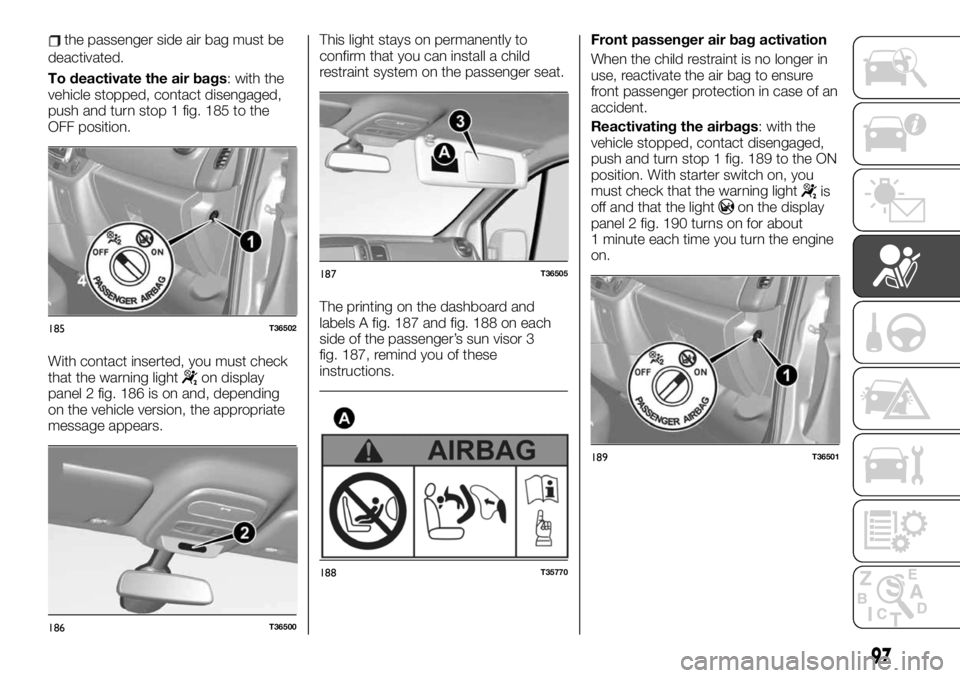
the passenger side air bag must be
deactivated.
To deactivate the air bags: with the
vehicle stopped, contact disengaged,
push and turn stop 1 fig. 185 to the
OFF position.
With contact inserted, you must check
that the warning light
on display
panel 2 fig. 186 is on and, depending
on the vehicle version, the appropriate
message appears.This light stays on permanently to
confirm that you can install a child
restraint system on the passenger seat.
The printing on the dashboard and
labels A fig. 187 and fig. 188 on each
side of the passenger’s sun visor 3
fig. 187, remind you of these
instructions.Front passenger air bag activation
When the child restraint is no longer in
use, reactivate the air bag to ensure
front passenger protection in case of an
accident.
Reactivating the airbags: with the
vehicle stopped, contact disengaged,
push and turn stop 1 fig. 189 to the ON
position. With starter switch on, you
must check that the warning light
is
off and that the lighton the display
panel 2 fig. 190 turns on for about
1 minute each time you turn the engine
on.
185T36502
186T36500
187T36505
188T35770
189T36501
97
Page 100 of 236
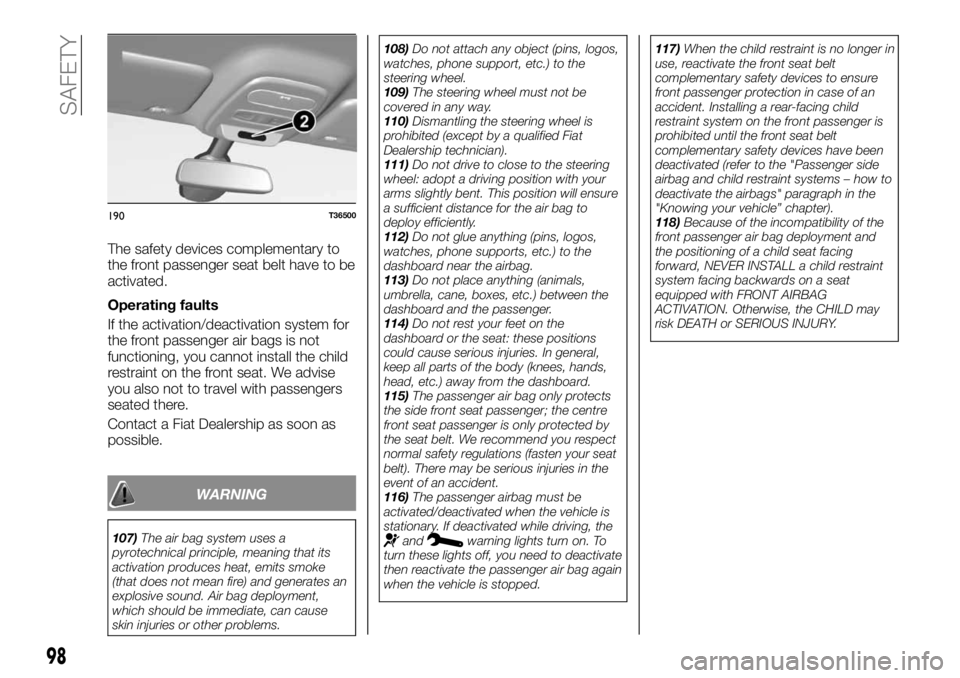
The safety devices complementary to
the front passenger seat belt have to be
activated.
Operating faults
If the activation/deactivation system for
the front passenger air bags is not
functioning, you cannot install the child
restraint on the front seat. We advise
you also not to travel with passengers
seated there.
Contact a Fiat Dealership as soon as
possible.
WARNING
107)The air bag system uses a
pyrotechnical principle, meaning that its
activation produces heat, emits smoke
(that does not mean fire) and generates an
explosive sound. Air bag deployment,
which should be immediate, can cause
skin injuries or other problems.108)Do not attach any object (pins, logos,
watches, phone support, etc.) to the
steering wheel.
109)The steering wheel must not be
covered in any way.
110)Dismantling the steering wheel is
prohibited (except by a qualified Fiat
Dealership technician).
111)Do not drive to close to the steering
wheel: adopt a driving position with your
arms slightly bent. This position will ensure
a sufficient distance for the air bag to
deploy efficiently.
112)Do not glue anything (pins, logos,
watches, phone supports, etc.) to the
dashboard near the airbag.
113)Do not place anything (animals,
umbrella, cane, boxes, etc.) between the
dashboard and the passenger.
114)Do not rest your feet on the
dashboard or the seat: these positions
could cause serious injuries. In general,
keep all parts of the body (knees, hands,
head, etc.) away from the dashboard.
115)The passenger air bag only protects
the side front seat passenger; the centre
front seat passenger is only protected by
the seat belt. We recommend you respect
normal safety regulations (fasten your seat
belt). There may be serious injuries in the
event of an accident.
116)The passenger airbag must be
activated/deactivated when the vehicle is
stationary. If deactivated while driving, theandwarning lights turn on. To
turn these lights off, you need to deactivate
then reactivate the passenger air bag again
when the vehicle is stopped.117)When the child restraint is no longer in
use, reactivate the front seat belt
complementary safety devices to ensure
front passenger protection in case of an
accident. Installing a rear-facing child
restraint system on the front passenger is
prohibited until the front seat belt
complementary safety devices have been
deactivated (refer to the "Passenger side
airbag and child restraint systems – how to
deactivate the airbags" paragraph in the
"Knowing your vehicle” chapter).
118)Because of the incompatibility of the
front passenger air bag deployment and
the positioning of a child seat facing
forward, NEVER INSTALL a child restraint
system facing backwards on a seat
equipped with FRONT AIRBAG
ACTIVATION. Otherwise, the CHILD may
risk DEATH or SERIOUS INJURY.
190T36500
98
SAFETY
Page 102 of 236
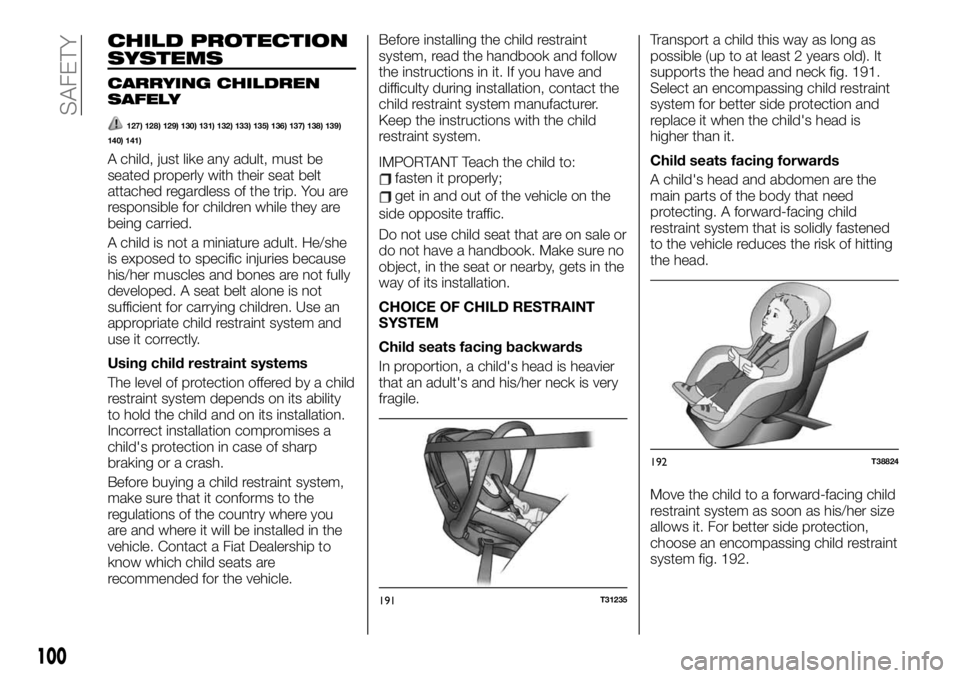
CHILD PROTECTION
SYSTEMS
CARRYING CHILDREN
SAFELY
127) 128) 129) 130) 131) 132) 133) 135) 136) 137) 138) 139)
140) 141)
A child, just like any adult, must be
seated properly with their seat belt
attached regardless of the trip. You are
responsible for children while they are
being carried.
A child is not a miniature adult. He/she
is exposed to specific injuries because
his/her muscles and bones are not fully
developed. A seat belt alone is not
sufficient for carrying children. Use an
appropriate child restraint system and
use it correctly.
Using child restraint systems
The level of protection offered by a child
restraint system depends on its ability
to hold the child and on its installation.
Incorrect installation compromises a
child's protection in case of sharp
braking or a crash.
Before buying a child restraint system,
make sure that it conforms to the
regulations of the country where you
are and where it will be installed in the
vehicle. Contact a Fiat Dealership to
know which child seats are
recommended for the vehicle.Before installing the child restraint
system, read the handbook and follow
the instructions in it. If you have and
difficulty during installation, contact the
child restraint system manufacturer.
Keep the instructions with the child
restraint system.
IMPORTANT Teach the child to:
fasten it properly;
get in and out of the vehicle on the
side opposite traffic.
Do not use child seat that are on sale or
do not have a handbook. Make sure no
object, in the seat or nearby, gets in the
way of its installation.
CHOICE OF CHILD RESTRAINT
SYSTEM
Child seats facing backwards
In proportion, a child's head is heavier
that an adult's and his/her neck is very
fragile.Transport a child this way as long as
possible (up to at least 2 years old). It
supports the head and neck fig. 191.
Select an encompassing child restraint
system for better side protection and
replace it when the child's head is
higher than it.
Child seats facing forwards
A child's head and abdomen are the
main parts of the body that need
protecting. A forward-facing child
restraint system that is solidly fastened
to the vehicle reduces the risk of hitting
the head.
Move the child to a forward-facing child
restraint system as soon as his/her size
allows it. For better side protection,
choose an encompassing child restraint
system fig. 192.
191T31235
192T38824
100
SAFETY
Page 103 of 236
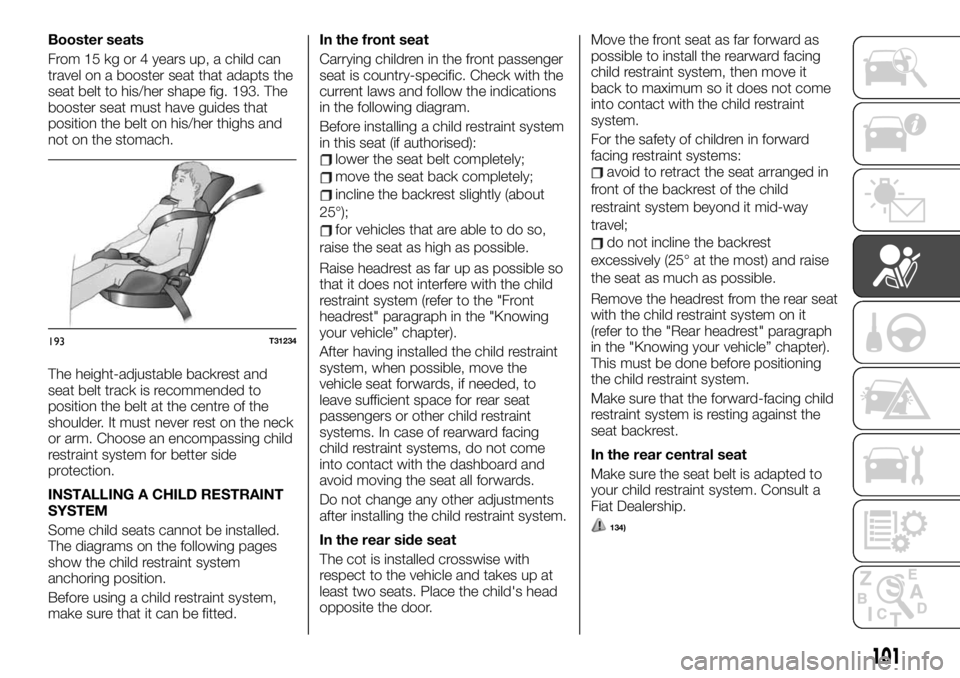
Booster seats
From 15 kg or 4 years up, a child can
travel on a booster seat that adapts the
seat belt to his/her shape fig. 193. The
booster seat must have guides that
position the belt on his/her thighs and
not on the stomach.
The height-adjustable backrest and
seat belt track is recommended to
position the belt at the centre of the
shoulder. It must never rest on the neck
or arm. Choose an encompassing child
restraint system for better side
protection.
INSTALLING A CHILD RESTRAINT
SYSTEM
Some child seats cannot be installed.
The diagrams on the following pages
show the child restraint system
anchoring position.
Before using a child restraint system,
make sure that it can be fitted.In the front seat
Carrying children in the front passenger
seat is country-specific. Check with the
current laws and follow the indications
in the following diagram.
Before installing a child restraint system
in this seat (if authorised):
lower the seat belt completely;
move the seat back completely;
incline the backrest slightly (about
25°);
for vehicles that are able to do so,
raise the seat as high as possible.
Raise headrest as far up as possible so
that it does not interfere with the child
restraint system (refer to the "Front
headrest" paragraph in the "Knowing
your vehicle” chapter).
After having installed the child restraint
system, when possible, move the
vehicle seat forwards, if needed, to
leave sufficient space for rear seat
passengers or other child restraint
systems. In case of rearward facing
child restraint systems, do not come
into contact with the dashboard and
avoid moving the seat all forwards.
Do not change any other adjustments
after installing the child restraint system.
In the rear side seat
The cot is installed crosswise with
respect to the vehicle and takes up at
least two seats. Place the child's head
opposite the door.Move the front seat as far forward as
possible to install the rearward facing
child restraint system, then move it
back to maximum so it does not come
into contact with the child restraint
system.
For the safety of children in forward
facing restraint systems:
avoid to retract the seat arranged in
front of the backrest of the child
restraint system beyond it mid-way
travel;
do not incline the backrest
excessively (25° at the most) and raise
the seat as much as possible.
Remove the headrest from the rear seat
with the child restraint system on it
(refer to the "Rear headrest" paragraph
in the "Knowing your vehicle” chapter).
This must be done before positioning
the child restraint system.
Make sure that the forward-facing child
restraint system is resting against the
seat backrest.
In the rear central seat
Make sure the seat belt is adapted to
your child restraint system. Consult a
Fiat Dealership.
134)
193T31234
101
Page 104 of 236
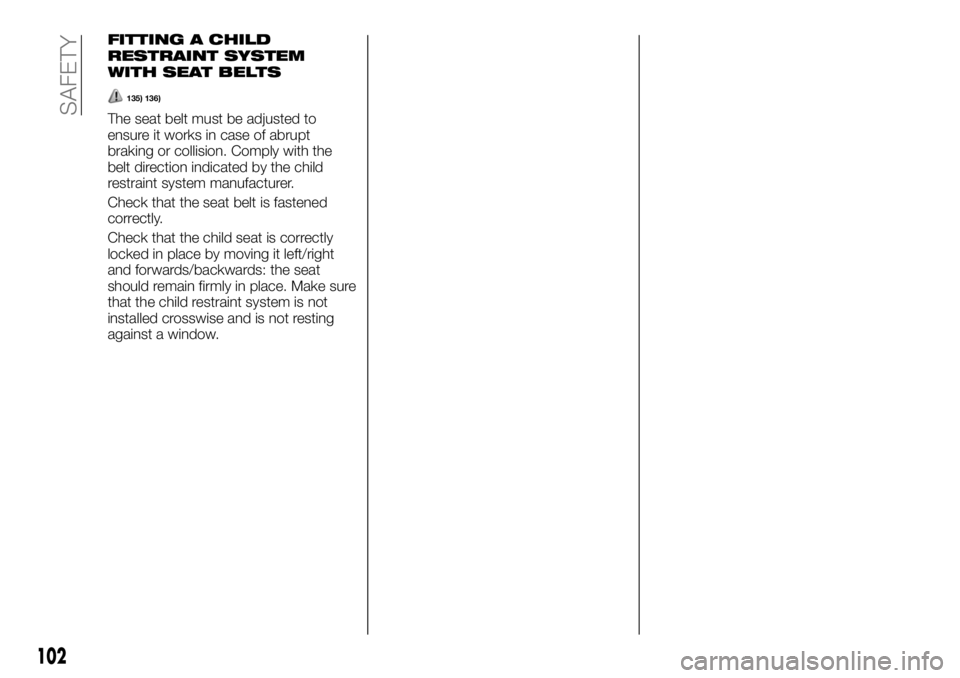
FITTING A CHILD
RESTRAINT SYSTEM
WITH SEAT BELTS
135) 136)
The seat belt must be adjusted to
ensure it works in case of abrupt
braking or collision. Comply with the
belt direction indicated by the child
restraint system manufacturer.
Check that the seat belt is fastened
correctly.
Check that the child seat is correctly
locked in place by moving it left/right
and forwards/backwards: the seat
should remain firmly in place. Make sure
that the child restraint system is not
installed crosswise and is not resting
against a window.
102
SAFETY
Page 107 of 236
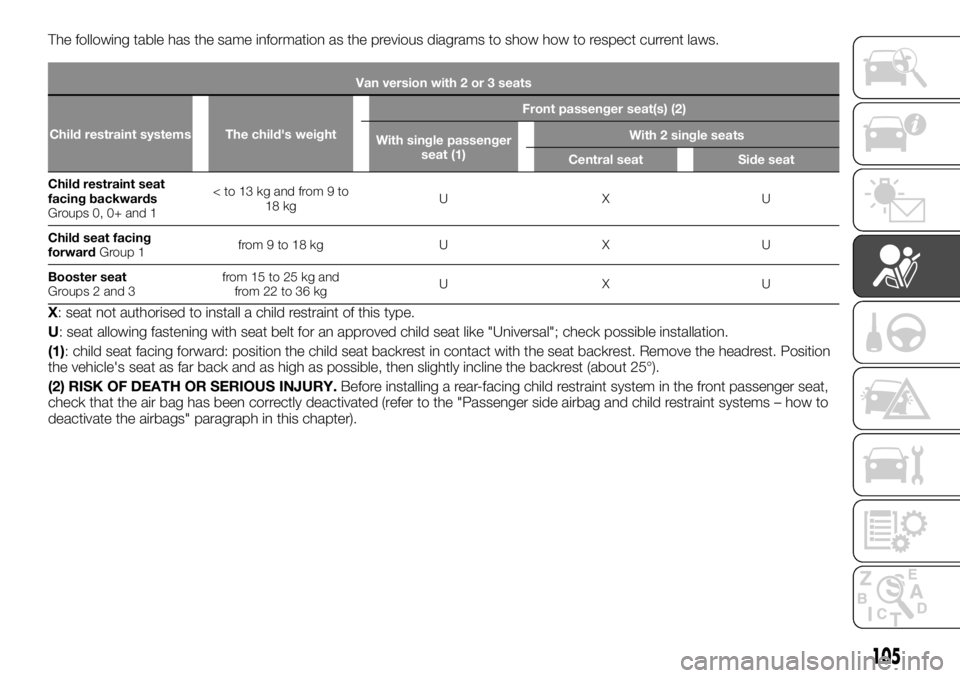
The following table has the same information as the previous diagrams to show how to respect current laws.
Van version with 2 or 3 seats
Child restraint systems The child's weightFront passenger seat(s) (2)
With single passenger
seat (1)With 2 single seats
Central seat Side seat
Child restraint seat
facing backwards
Groups 0, 0+ and 1
Child seat facing
forwardGroup 1from9to18kg U X U
Booster seatfrom 15 to 25 kg and
from 22 to 36 kgUXU
X: seat not authorised to install a child restraint of this type.
U: seat allowing fastening with seat belt for an approved child seat like "Universal"; check possible installation.
(1): child seat facing forward: position the child seat backrest in contact with the seat backrest. Remove the headrest. Position
the vehicle's seat as far back and as high as possible, then slightly incline the backrest (about 25°).
(2) RISK OF DEATH OR SERIOUS INJURY.Before installing a rear-facing child restraint system in the front passenger seat,
check that the air bag has been correctly deactivated (refer to the "Passenger side airbag and child restraint systems – how to
deactivate the airbags" paragraph in this chapter).
105
Groups 2 and 3
Page 109 of 236
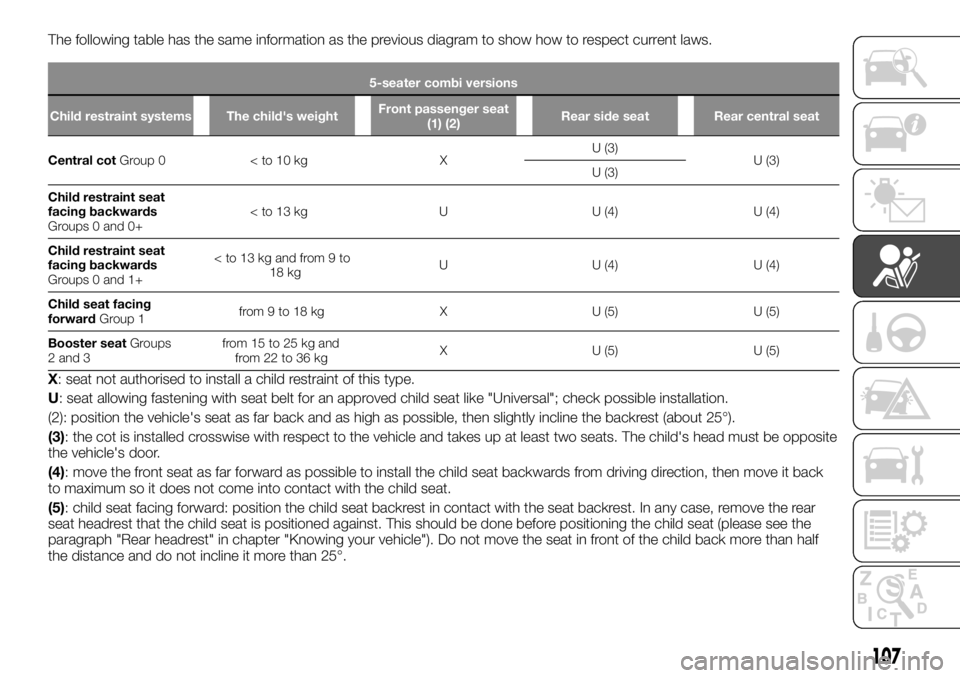
The following table has the same information as the previous diagram to show how to respect current laws.
5-seater combi versions
Child restraint systems The child's weightFront passenger seat
(1) (2)Rear side seat Rear central seat
Central cotGroup 0 < to 10 kg XU (3)
U (3)
U (3)
Child restraint seat
facing backwards
Groups 0 and 0+
facing backwards
Groups 0 and 1+
Child seat facing
forwardGroup 1from9to18kg X U(5) U(5)
Booster seatGroups
2 and 3from 15 to 25 kg and
from 22 to 36 kgX U (5) U (5)
X: seat not authorised to install a child restraint of this type.
U: seat allowing fastening with seat belt for an approved child seat like "Universal"; check possible installation.
(2): position the vehicle's seat as far back and as high as possible, then slightly incline the backrest (about 25°).
(3): the cot is installed crosswise with respect to the vehicle and takes up at least two seats. The child's head must be opposite
the vehicle's door.
(4): move the front seat as far forward as possible to install the child seat backwards from driving direction, then move it back
to maximum so it does not come into contact with the child seat.
(5): child seat facing forward: position the child seat backrest in contact with the seat backrest. In any case, remove the rear
seat headrest that the child seat is positioned against. This should be done before positioning the child seat (please see the
paragraph "Rear headrest" in chapter "Knowing your vehicle"). Do not move the seat in front of the child back more than half
the distance and do not incline it more than 25°.
107